|
Alien, or exotic species, pose a serious threat to the natural environment of Catoctin Mountain Park. 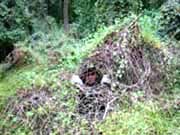
(NCR-EPMT) PLANTSIntroduced here without any natural predators to keep them in check, invasive plant species are able to outcompete native vegetation for sunlight and nutrients. Alien species tend to have abnormally rapid growth rates and can survive in less than ideal growing conditions, such as disturbed land areas or drought conditions. However, not all exotic plant species are necessarily invasive. At Catoctin Mountain Park there are over 100 known exotic plants, but only a handful of these are designated as invasive species that require management. The top invaders include:
Mile-a-Minute, Polygonum perfoliatum. Native of India to East Asia this extremely fast growing vine uses curved barbs to climb over other vegetation. Equal-sided triangular leaves also distinguish it. Mile-a-Minute smothers plants and tree seedlings by blocking sunlight. First recorded in North America in 1890, this vine began its invasion when it escaped from a nursery in York County, Pennsylvania, in the 1930's. Beefsteak Plant, Perilla frutescens. Native of India to East Asia this aromatic plant is sold commercially for use in landscaping. It is also used medicinally to treat a wide range of ailments, including asthma and coughs. Beefsteak is tolerant to a wide range of conditions and has a high rate of maturation, making it an aggressive competitor with native plants. Park road shoulders are a common location for beefsteak colonies. In the winter you may find their dry stems left standing like skeletons from the previous summer. Japanese Stiltgrass, Microstegium vimineum. Native of India to East Asia this grass was first recorded in Tennessee in 1909. At that time the grass was commonly used as a packing material for Asian porcelain, and it is thought that escaped seeds started the invasion. Up to 1,000 seeds are produced by each plant, allowing this shade tolerant species to carpet forest floors. Growing up to 3 feet in height, this sprawling annual has long, thin leaves that alternate up its stalk. Road and trail corridors are common places to find this grass in the park. Garlic Mustard, Alliaria petiolata. Native to Europe this biennial understory herb is a member of the mustard family. The coarsely toothed leaves are triangular to heart-shaped, and when crushed give off a garlic smell. Garlic mustard is a threat because of its ability to aggressively invade woodland communities and displace native grasses, shrubs and tree seedlings. First recorded in North America in 1868 in Long Island, New York, this herb was intentionally introduced for use in cooking, erosion prevention, and medicinal treatment of gangrene and ulcers. Tree of Heaven, Ailanthus altissima. Native to Central China this rapidly growing deciduous tree has pale gray bark and alternate compound leaves of 11-41 leaflets. This tree thrives in adverse conditions and can grow up to 8 feet in a single year. It is tolerant of a wide range of ecological stresses and can even proliferate in disturbed urban areas, such as alleys, sidewalks, and parking lots. It has an aggressive root system known to damage sewers and building foundations. Though the trees can reach up to 100 feet they cannot be used for lumber due to their poor quality. It was first introduced in 1784 by a gardener in Philidelphia, Pennsylvania, and is now found throughout the United States. Multiflora Rose, Rosa multiflora. Native of Japan, Korea, and eastern China this member of the rose family has hooked thorns along its arching stems. Introduced from Japan in 1866 it has been used for erosion control, ornamental purposes, and to create "living fences" to confine livestock. Despite its uses, multiflora rose is listed as an alien invasive because of its habit of spreading into fields and pastures, forming impenetrable thickets that exclude all other plants. Japanese Barberry, Berberis thunbergii. Native to Japan this low, compact shrub has small leaves of green, gold, or maroon. The small straight spines that line the branches can distinguish barberry. Introduced in 1864 as an ornamental shrub it is still a popular landscape shrub available for sale to the public. Barberry is quick to escape to the wild where it can tolerate shade, severe drought, and extreme winters. Other alien invaders include Japanese honeysuckle (Lonicera japonicus) and Canada thistle (Cirsium arvense).
Exotic species in the park are mostly found alongside roads and trails. Roads and trails serve as vectors for these plants with seeds hitchhiking on car tires, visitors' shoelaces, or even attached to the fur of wild animals. Unfortunately, a few species like Japanese Barberry and Garlic Mustard have spread beyond roads and trails and have permeated into all regions of the park. Another popular place for exotic invasions is around stream corridors. Moving water quickly transports seeds downstream to infest new areas. The resource staff at Catoctin Mountain Park along, with the assistance of the regional Exotic Plant Management Team, have begun an intensive program to control the spread of invasive vegetation in the park. Infested areas have been restored by using mechanical methods, such as mowing and handpulling, combined with chemical and cultural methods when neccessary. The goal is not to eliminate exotic vegetation completely, but rather to control its spread and prevent smothering monocultures from forming.
Didymo Research shows that didymo reduces the population of larger insects leaving only smaller insects for trout to eat, often resulting in smaller trout sizes. Fishing in didymo-infested waters could result in tangled lures and the spread of the algae if equipment is not cleaned properly. 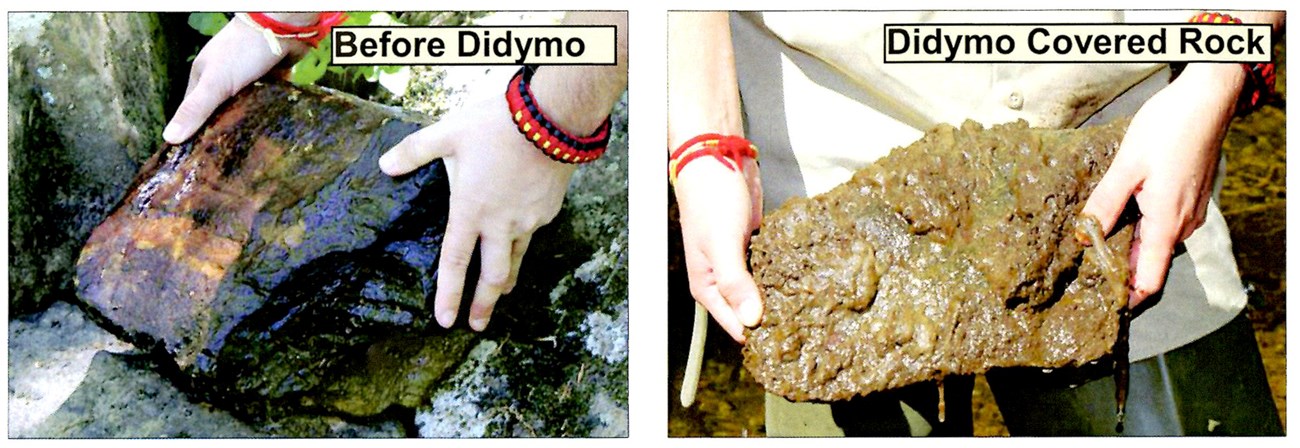
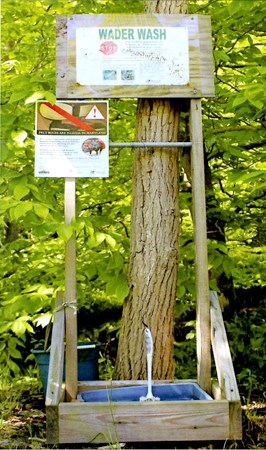
With your help, we can slow the spread of didymo and protect our streams for future generations.
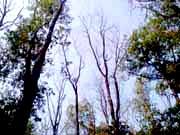
NPS Photo/ Jeremy Murphy
Catoctin Mountain Park also has some non-native animal species that are considered pests such as the spongy moth and the hemlock woolly adelgid. Spongy MothSince its accidental introduction in eastern Massachusetts in the late 1860's, the European strain of the spongy moth (Lymantria dispar, formerly called "gypsy moth") has been spreading. In 1994 it was considered a permanent resident in 16 northeastern states. The spongy moth caterpillar can be extremely disruptive to the forest ecosystem. Caterpillars feed on the leaves of hardwood trees, particularly oak, which can result in complete defoliation of the tree. Defoliation reduces the vigor and general health of forests and shade trees, leads to tree death which can alter wildlife habitat and change water quality and quantity. Hemlock Woolly AdelgidThe hemlock woolly adelgid (Adelges tsugae) is another pest that is affecting Catoctin. Introduced from Asia in 1924 this insect primarily attacks eastern hemlock and Carolina hemlock trees. The hemlock wooly adelgid injures a hemlock by sucking sap from the young twigs causing needles to discolor and drop prematurely. Complete defoliation and tree death can occur in a few years. 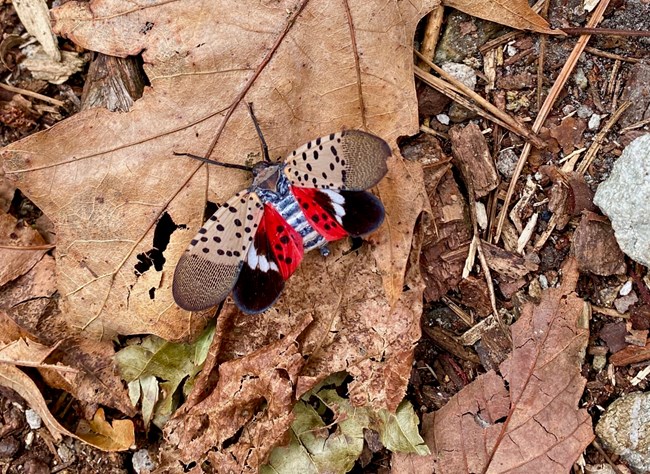
NPS Photo/ Glynn Wilson Spotted LanternflySpotted Lanternflies (Lycorma delicatula) were found in the summer of 2022 at Catoctin Mountain Park. Lanternflies are leaf hoppers that were accidentally introduced into Pennsylvania in 2014. They were first found in Maryland in 2018 (PSU website). You might see them at the park, at home or while visiting other places. They are attracted to another invasive exotic, tree of heaven Ailanthus altissima. Mostly, they are generalists, that feed on a wide variety of trees and vines. |
Last updated: November 4, 2022
